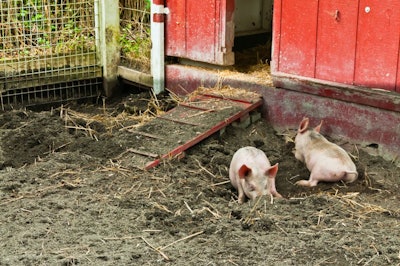
Helping animals cope with heat stress through nutrition is one of the ways to alleviate the negative impact of summer.
There is no better time than at the beginning of summer to reconsider nutrition in terms of heat stress alleviation.
As it has been repeated often, high-producing animals in confinement suffer from high feed intake that yields an excess amount of metabolic heat. This increases animal discomfort, resulting in reduced feed intake and, subsequently, performance. Non-nutritional measures to reduce animal discomfort should also be considered, but here we focus only on nutrition.
We will briefly discuss three major elements of summer feeding:
- Reformulation in terms of nutrients
- Additives that reduce caloric burden
- Feeding management
As always, it is highly recommended to discuss this topic with a qualified nutritionist to custom fit each nutritional program to the needs and abilities of each operation.
Reformulating nutrients
There are two nutrients that increase heat burden under high feed intake. The heat increment from metabolizing and excreting excess crude protein is considerable, so it is always recommended to minimize it in summer formulations. The difference should be made by using feed-grade amino acids to ensure animals continue to perform at their best potential.
The second nutrient to consider is fermentable fiber that results in excess hind gut fermentation, which obviously yields temperature. Again, how low to go depends on available ingredients, the age of the animal, and the reason why fermentable fiber was there in the first place.
Reformulating to lower these two dietary specifications (protein and fiber) alone will alleviate the problem of summer heat stress, but it is not enough. Finally, increasing dietary electrolyte balance has been shown to increase water intake, but this is achieved by adding certain mineral salts discussed below.
Additives that alleviate heat stress
The next step in confronting heat stress is to include certain additives that have a proven record in mitigating this problem. Which ones to add in each formula depends on previous experiences in each specific farm operation, the type of animal, and the nature of the feed ingredients being used. A short list is presented below for consideration:
- Sodium bicarbonate added up to 0.1% can improve feed intake, especially in older animals. Feeding sodium bicarbonate to young pigs is strongly discouraged as this ingredient tends to buffer stomach pH.
- Potassium chloride (and ammonium chloride) have been shown to improve growth performance, especially in broilers, but only when used within the context of equilibrating the dietary electrolyte balance of a diet.
- Vitamin C, although not required by mammals or birds under normal conditions, has been shown to alleviate the symptoms of heat stress by reducing oxidative stress and improving immunity under stress conditions. Best results are obtained when vitamin C is used in water.
- Betaine is a methyl donor (spares part of methionine requirement), but it is also a potent osmoregulator that has been shown to be of benefit in animals suffering from water dehydration. Betaine acts by balancing water levels inside the cells and alleviates the negative effects of accumulated inorganic ions that destabilize cellular enzymes and other proteins (as it happens when the salts described above are used at excessive amounts).
- Sodium zeolite is a natural clay that has been shown to reduce the effects of heat stress, on laying hens especially, but it can be safely assumed it will perform similarly in other monogastric animals. Although its exact mode of action is unknown, it is speculated it acts as a buffer in the gastrointestinal system, reducing alkalosis associated with panting.
- Common salt (sodium chloride) added at a slightly higher level will increase thirst and, assuming animals have free access to non-saline water, this will induce them to drink more water. Naturally, water is one of the best ways to combat heat stress and dehydration.
Feeding management
Here, we depart from formulation and we focus on how we feed the animals. Two topics will be discussed as these have been the most effective in combating heat stress.
First, feeding animals one or two large meals per day forces them to process an amount of feed that is not natural for them. If animals have free access to feed, they can regulate their intake, but then, they will reduce overall feed consumed. To this end, pelleting helps to increase nutrient intake. For animals on restricted feed, it is recommended to increase feeding frequency to include at least three meals per day, and even more if possible.
Second, feeding animals in the cooler times of the day (early morning and late evening) is best when heat waves make life impossible. During such harsh times, animals will simply refuse to eat and wait for the cooler times of the day. Heat (and moisture often associated with it) will spoil any feed offered during the day and refused until the night, reducing its nutritive value, palatability and, if high in fat and oils, will impact animal health negatively. Unless feeding is automated, labor is difficult to be secured to feed animals at non-working hours, especially in very large operations.

















